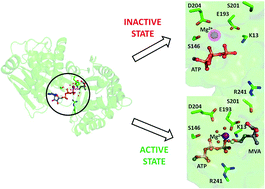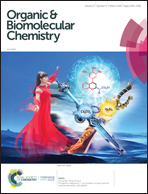Catalytic mechanism of mevalonate kinase revisited, a QM/MM study†
Abstract
Mevalonate Kinase (MVK) catalyses the ATP-Mg2+ mediated phosphate transfer of mevalonate to produce mevalonate 5-phosphate and is a key kinase in the mevalonate pathway in the biosynthesis of isopentenyl diphosphate, the precursor of isoprenoid-based biofuels. However, the crystal structure in complex with the native substrate mevalonate, ATP and Mg2+ has not been resolved, which has limited the understanding of its reaction mechanism and therefore its application in the production of isoprenoid-based biofuels. Here using molecular docking, molecular dynamics (MD) simulations and a hybrid QM/MM study, we revisited the location of Mg2+ resolved in the crystal structure of MVK and determined a catalytically competent MVK structure in complex with the native substrate mevalonate and ATP. We demonstrated that significant conformational change on a flexible loop connecting the α6 and α7 helix is induced by the substrate binding. Further, we found that Asp204 is coordinated to the Mg2+ ion. Arg241 plays a crucial role in organizing the triphosphoryl tail of ATP for in-line phosphate transfer and stabilizing the negative charge that accumulates at the β,γ-bridging oxygen of ATP upon bond cleavage. Remarkably, we revealed that the phosphorylation of mevalonate catalyzed by MVK occurs via a direct phosphorylation mechanism, instead of the conventionally postulated catalytic base mechanism. The catalytically competent complex structure of MVK as well as the mechanism of reaction will pave the way for the rational engineering of MVK to exploit its applications in the production of biofuels.

- This article is part of the themed collection: Mechanistic, computational & physical organic chemistry in OBC


 Please wait while we load your content...
Please wait while we load your content...